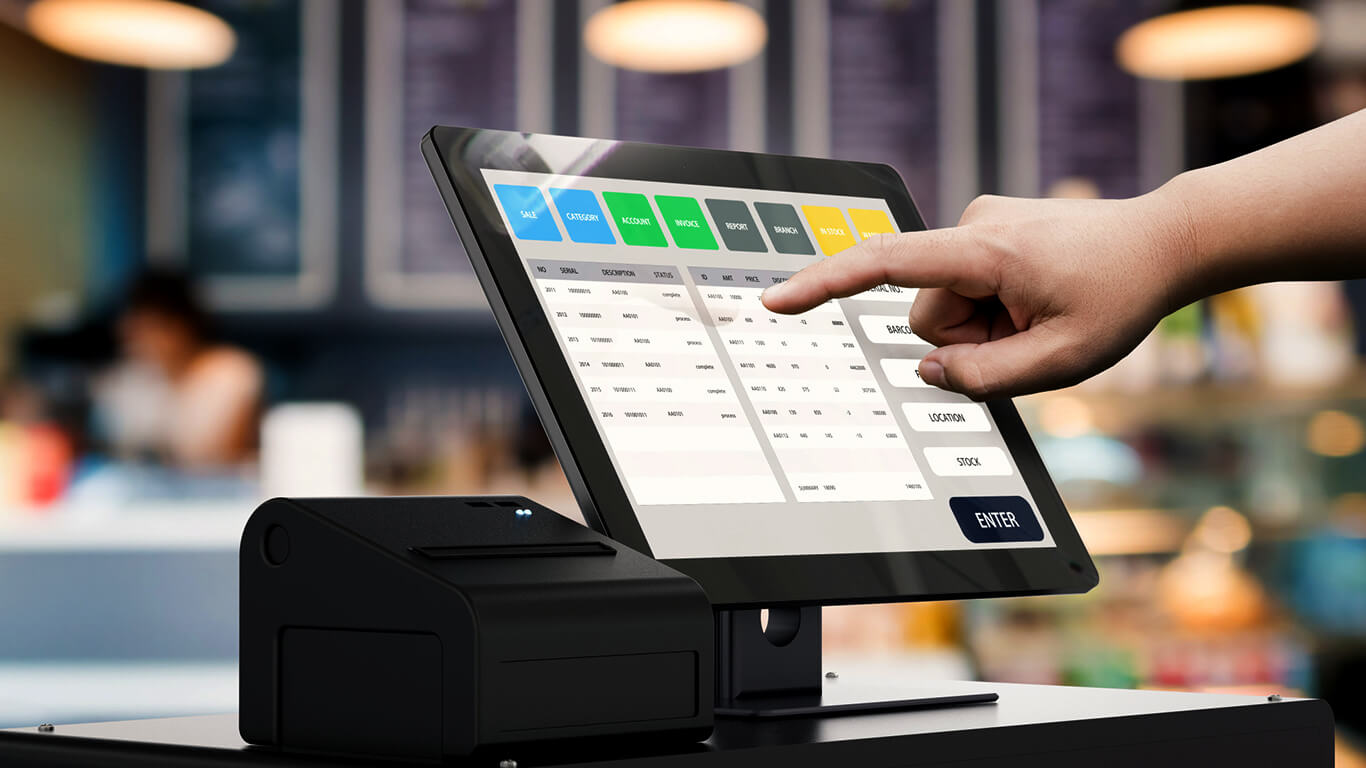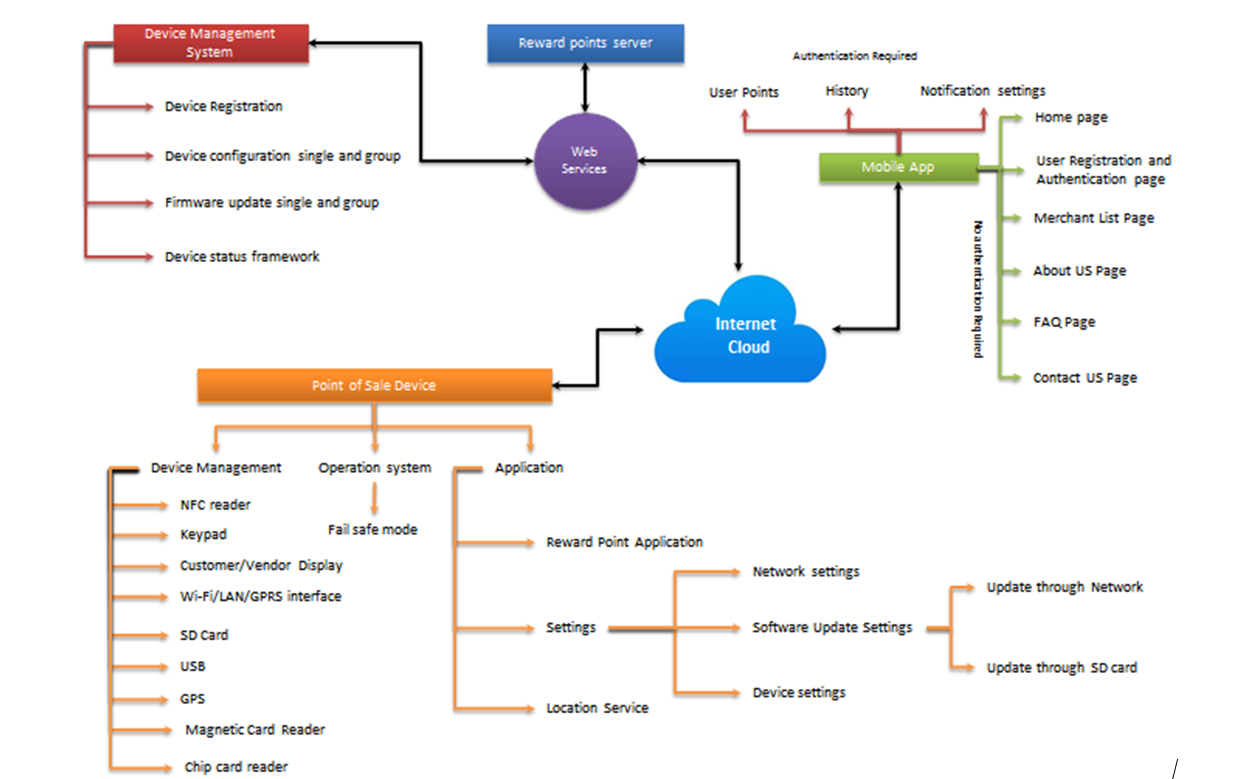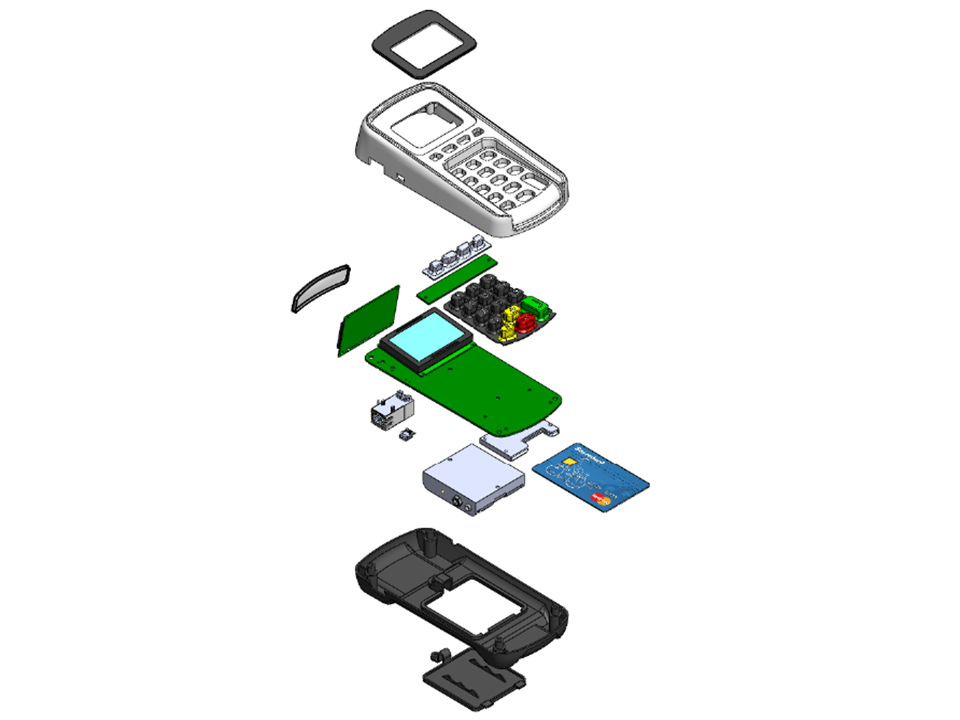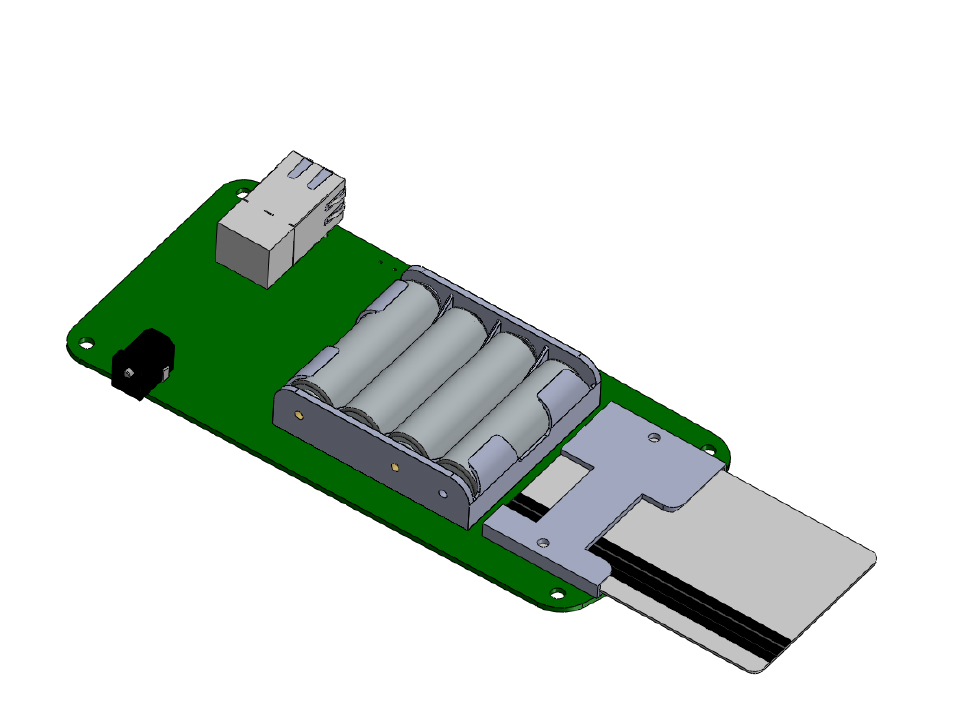- Dual display (Customer interfacing reward points display)
- 8-Hrs battery backup with single charge (GPS+3G) enables to track the POS wherever is moves across
- Listen before talk feature enables to convert truncations geographic specific (Conversion rates)
- Universal NFC interface (Phones,tags can communicate Read/Write option)
- Micro cloud interface enables standalone POS to communicate with the cloud
- Info-Push notifications to the APP through server
- Realtime Linux kernel driven – should have no latency
- Embedded webserver , DHCP , NAT , PAT , Firewall – Handling
- 6LoWPAN Mesh (IPv6-IPv4 tunneling)
- Over the Air Programming with 802.15.4 and ZigBee / BLE / Wifi
- Remote firmware upgrade – Preprovisioning POS nodes
- Inbuilt GPS receiver should push NEMA data – which is stratight forward
- Low power Bluetooth / LBE – modules interface through USB (Bluegiga-SiliconLabs) modules can be interfaced
- Biometric identification – Module interface
Device Management System
- Device Registration
- Gives web interface to register new device with serial number with operator information for tracking.
- Device configuration single and group
- Gives option to configuration devices on the air.
- Device can run with default configuration or based on operation inputs.
- Give option to select the device connected to server for configuration (Single or group).
- Firmware update single or group
- Gives option to update firmware on the air.
- Device can run with default firmware from SD card.
- Give option to select the device connected to server for firmware update (Single or group).
- Device Status
- Gives interface to list of device connected to the network
- Location information
- Firmware version running
- Configuration
- Operator details
- Battery Status
- Battery Threshold settings with view/edit option
Wireless Communication
GSM/GPRS
This is a wireless interface through SIM card provided by third party service provider with GPRS enabled in 2G/3G mode. Special SIM slot will be provided for inserting the SIM card in device which enables the internet connectivity to device. Device will communicate with remote RPS (Reward Point Serve – Customer End) through GPRS for following application.
- User Authentication.
- User reward point collection.
- User based merchant list.
- User reward point modify (add, delete and update).
Device can also connect to the remote FUS (Firmware Upgrade Server) for upgrading the software on the air. Separate OTAU (On the Air Upgrade) protocols handled to control the upgrade functionality from server.
Wi-Fi
This wireless interface used in Wi-Fi hotspot area. Device will communicate to RPS and FUS units through internet enabled by Wi-Fi hotspot. Wi-Fi device supported with b/g/n wireless standards.
GPS
It is a standard GPS device which gives the latitude and longitude data of the device present. This latitude and longitude are recorded in remote server to log the location of the device in various time duration based on user input.
Wire Communication
Mini-USB
Mini Female connector provided for the following application.
- Power charging- Alternate for the main charger.
- Upgrade software from local PC.
- Access SD card data.
Ethernet – LAN
This is a 1G interface used to connect the device to internet through LAN cable where device will access the RPS and FUS units.
External Memory SD Card
This external memory used for failsafe operation. This will be loaded with failsafe image where it will be accessed by the boot loader when OS or Application failed to run. This fail safe image will be the default good running configuration. This will be useful when remote upgrade interrupted or failed.
Power Supply
Even we can use both power supply and backup from battery. AC adapter used to operate the device and charge the battery for remote locations. Battery management system monitors the battery charging and discharging operations and informs the user based on the higher and lower threshold limits by user. This takes care of cutoff the power supply when it reaches the higher threshold limits.
User Interface
Operator display
128X64 GLCD interface is connected for display application option to user. Display settings will be configured by user application on the device or remote configuration rom server.
Customer Display
This is a 1 line OLED additional display which connected at front of the device. This is used to display only reward points of the customer during the NFC card identified.
NFC Rear write terminal
NFC (near field communications) is based on RFID technology. There are many ways to use this NFC technology. For example peer to peer mode where two devices can exchange data (business card sharing), reader and writer mode (reading NFC enable smart poster)
A POS is any pocket-sized card with embedded integrated circuits that can process and store data, and communicate with a terminal via radio waves. POSs can be used for identification, authentication, and data storage. They also provide a means of effecting business transactions in a flexible, secure, standard way with minimal human intervention
NFC read/Write device which supports following ISO standards
- ISO 14443A
- ISO 14443B
- ISO 15693
- ISO 18000-3
- ISO 18092
Magnetic Swipe Card Reader
Credit card readers, or magnetic stripe readers (MSR), are used to read the magnetic stripe on plastic cards, gift cards, credit cards, driver’s licenses, security badges, etc. They’re most often used for credit cards. Mag stripes have 1, 2, or 3 tracks of data. Gift cards, id cards and other specialty cards often use track 3.
Chip Card Reader
Chip & PIN cards have an embedded microchip that works with a Personal Identification Number PIN instead of a cardholder signature. Chip technology offers the single most important benefit in payment transactions – enhanced security. The chip ensures that the card is authentic, and the PIN ensures that the cardholder is the rightful cardholder.
Keypad/ Touch Screen
12X3X4 Keypad comes with 12 standard keys with separate ok, clear and cancels buttons. Additional 4 functional buttons for menu selection operations.
One area that will play a prominent role in the future supply chain, as it’s impacted by IoT, is in-transit visibility. The logistics ecosystem has many players, and thus, many moving parts. Products are handled and transferred between the manufacturer, suppliers, the distribution center, retailer, and customer. This many nodes in the supply chain calls for an agile and informed supply network in regards to product whereabouts and other specifications.
Key to in-transit visibility are cloud-based GPS and Radio Frequency Identification (RFID) technologies, which provide identity, location, and other tracking information. These are the backbone of IoT as it relates to the supply chain. By tapping the data gathered by these technologies, detailed visibility of an item is provided all the way from the manufacturer to the retailer. Data gathered from GPS and RFID technologies not only allows supply chain professionals to automate shipping and delivery by exactly predicting the time of arrival; they can monitor important details like temperature control, which impact the quality of a product in-transit.
IoT will bring all of this together in the following way: By putting an RFID chip in a pallet, for example, and a combined integrated device in the shipment vehicle, data is transferred into the cloud, and the devices can identify the pallet and not only share its position using GPS coordinates, but also bring in other data like weather conditions, traffic conditions, and driver-specific data (i.e., driving pattern, average speed).
Combining real-time sensor data with environmental data can provide intelligence of higher order to all the stakeholders in the ecosystem. This allows the stakeholders to be socially aware and make efficient decisions that drive overall productivity. This moves the supply chain process from a reactive mode to a proactive one by offering information well before any activity happens.
For example, providing information about a traffic jam and potential delay before the trip starts has much higher value than getting that alert when one is already stuck in the traffic. This context-aware intelligence can enhance the supply chain visibility by implementing IoT.
Clearly this scenario can be applied to others in the supply chain – from the manufacturer to the end user, the Internet of Things means richer data and deeper intelligence for all parties in a supply network. And that doesn’t just apply to product visibility. By allowing devices to “talk to each other” in the right way, IoT can help supply chain professionals:
- Reduce asset loss. Know about product issues in time to find a solution.
- Save fuel costs. Optimize fleet routes by monitoring traffic conditions.
- Ensure temperature stability. Monitor the cold chain – according to the Food and Agriculture Organization of the United Nations, about one third of food perishes in transit every year.
- Manage warehouse stock. Monitor inventory to reduce out-of-stock situations.
- Gain user insight. Embedded sensors provide visibility into customer behavior and product usage.
- Create fleet efficiencies. Reduce redundancies – deadhead miles account for up to 10 percent of truck miles, according to the EPA, and 28 percent for private fleet trucks, according to the National Private Truck Council.
It should be noted that while IoT in this application is still nascent, supply chain management professionals should tune into the conversation now to consider its potential. Deeper intelligence into supply and demand will not only benefit manufacturers, distributors, and retailers, but also consumers, as their demands can be better met with this deeper level of intelligence. IoT for the supply chain and transportation industries is part of today’s larger-picture digital business landscape by which connected devices enable organizations to work smarter, plan better, and foster more intelligent decision making processes.







